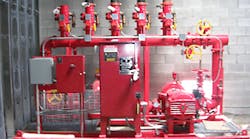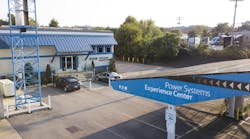Understanding Fire Pump Controller Applications
Fire pump controllers are control panels containing electrical components, such as circuit breaker, switches, relays, and other devices, dedicated to the operation of fire pumps. The devices within a fire pump controller panel perform such functions as: receiving signals from alarm devices, such as pressure operated switches, sprinkler alarm valves, or remote fire alarm equipment; activating motor control devices to provide electric power to motors driving fire pumps; and monitoring fire pump operation and performance.
All controllers are completely assembled, wired, and tested by the manufacturer before shipment from the factory. Some controllers need to be shipped in sections for various reasons, such as shipping limitations due to size. Controllers shipped in sections are completely assembled, wired, and tested by the manufacturer before shipment from the factory. Such controllers are reassembled in the field; their proper assembly is verified by the manufacturer or designated representative. Fire pump controllers suitable for use as service equipment are marked accordingly.
Full-service fire pump controllers
These devices are the most common controller type for an electric motor pump and are intended for use with standard-size, electric-driven centrifugal fire pumps using squirrel-cage or wound-rotor motors rated 600V or less. Controllers for squirrel-cage motors may be across-the-line starting or reduced-voltage starting as indicated in the individual listings.
Engine-type fire pump controllers
Designed for use with engine-driven pumps, these controllers are normally provided for control of diesel engines, but may also be provided for control of spark-ignition (gasoline or natural gas) engines.
Limited-service fire pump controllers
These devices are restricted to use with across-the-line type squirrel-cage motors rated 30 hp or less, 600V or less. Authorities Having Jurisdiction (AHJs) should be consulted before installing limited service controllers, because ANSI/NFPA 13, “Standard for the Installation of Sprinkler Systems,” has specific limitations on where and how limited-service fire pump controllers may be used.
Additive fire pump controllers
Intended for starting and stopping additive pump motors and marked “additive pump controller” or “limited-service additive pump controller,” these controllers are formerly known as “foam-concentrate pump controllers.”
Full-service fire pump controllers, engine-type fire pump controllers, limited service controllers, and additive fire pump controllers are listed by UL under the product category “Pump Controllers, Fire” (QYZS). UL evaluates fire pump controllers in this category using ANSI/UL 218, “The Standard for Safety for Fire Pump Controllers,” and ANSI/UL 508, “The Standard for Safety for Electric Industrial Control Equipment.”
Fire pump controllers in the QYZS category are intended for starting and stopping centrifugal fire pumps and include nonautomatic and automatic types for electric-driven pumps and combined manual and automatic types for engine-driven pumps. Fire pump controllers are intended for installation and use in ordinary locations in accordance with ANSI/NFPA 20, “Standard for the Installation of Stationary Pumps for Fire Protection” and ANSI/NFPA 70, “National Electrical Code.”
High-voltage fire pump controllers
This group is listed by UL under the product category “Pump Controllers, Fire, Over 600-Volts, (QZGR). High-voltage fire pump controllers have AC voltage ratings in the range of 2.2kV to 2.5kV, 4.0kV to 5.0kV, or 6.2kV to 7.2kV, and are intended for starting and stopping automatic or nonautomatic types of electric-driven centrifugal fire pumps.
The basic standards used to investigate high-voltage fire pump controllers are ANSI/UL 218, the “Standard for Safety for Fire Pump Controllers,” ANSI/UL 347, the “Standard for Safety for High Voltage Industrial Control Equipment,” and ANSI/ NFPA 20, “Standard for the Installation of Stationary Pumps for Fire Protection.” These controllers are intended for installation and use in accordance with ANSI/NFPA 20, “Standard for the Installation of Stationary Pumps for Fire Protection.”
Residential fire pump controllers
These devices are intended for starting, stopping, and protecting centrifugal fire pumps in one- and two-family dwellings and manufactured homes. These controllers are for electric-driven pumps of the automatic or nonautomatic type.
It is important to note that ANSI/NFPA 20, “Standard for the Installation of Stationary Pumps for Fire Protection,” does not specifically address residential fire pump controllers. Residential fire pump controllers are intended for installation and use in accordance with ANSI/NFPA 13D, “Standard for the Installation of Sprinkler Systems in One- and Two-Family Dwellings and Manufactured Homes.”
Listed by UL under the product category “Pump Controllers, Fire, Residential” (QZKE), these controllers are intended for use with squirrel-cage motors rated 250V or less and have been investigated for use on single-phase alternating-current circuits.
Residential fire pump controllers are evaluated by UL using ANSI/UL 218, the “Standard for Safety for Fire Pump Controllers,” ANSI/UL 508, the “Standard for Safety for Electric Industrial Control Equipment” and ANSI/NFPA 20, “Standard for the Installation of Stationary Pumps for Fire Protection,” as applicable to limited-service controllers.
Guide information for the product categories QYZS, QZGR, and QZKE is available in UL's Online Certifications Directory at www.ul.com/database and on page 276 of UL's “Guide Information For Electrical Equipment” (White Book).
This article is reprinted with permission from Underwriters Laboratories.
© 2009 by Penton Business Media Inc. All rights reserved



